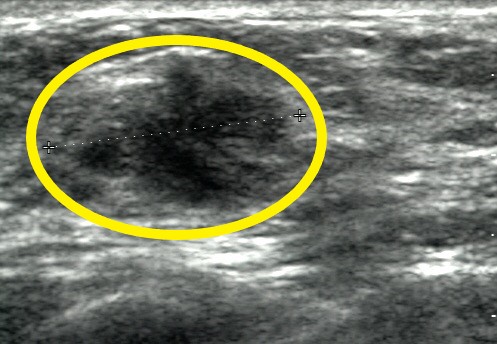Breast cancer echocardiography or ultrasound

|
Breast Cancer Microchapters |
|
Diagnosis |
|---|
|
Treatment |
|
Case Studies |
|
Breast cancer echocardiography or ultrasound On the Web |
|
American Roentgen Ray Society Images of Breast cancer echocardiography or ultrasound |
|
Risk calculators and risk factors for Breast cancer echocardiography or ultrasound |
Editor-In-Chief: C. Michael Gibson, M.S., M.D. [1]Associate Editor(s)-in-Chief: Soroush Seifirad, M.D.[2] Mirdula Sharma, MBBS [3]; Ammu Susheela, M.D. [4]
Overview
Breast ultrasound may be helpful in the diagnosis of breast cancer, especially, to further evaluate an abnormal mammogram and to distinguish between solid and cystic lesions. Ultrasonography is the first-line imaging method in pregnant women and women less than 30 years old with focal breast sign and symptoms. AlthoughUltrasonography might be used as an adjunct to mammography in women with increased breast density, it has not been shown to decrease mortality from breast cancer. Nevertheless, using ultrasound may increase the risk for false-positive findings, unnecessary breast biopsy, and follow-up imaging.
It has been shown that heart failure is prevalent in women being treated with this novel treatment. As a potentially serious side effect of this novel treatment, serial Echocardiography is recommended in all patients treated with trastuzumab.
Findings on ultrasound
- Ultrasonography is particularly effective to distinguish between a solid mass and a fluid-filled cyst.
- It is often combined with mammography for a more thorough evaluation of breast tissue.
- Because Small calcium buildups are hard to detect with ultrasound
- Breast ultrasound is not as sensitive as mammography in diagnosing breast cancer.
- It may be used to:[1]
- Examine a breast lump or abnormality found during a clinical breast examination or mammogram
- Determine if a breast lump is a solid tumor or a fluid-filled cyst (sac in the body that is usually filled with fluid or semi-solid material)
- Find an abnormal area for a biopsy
- To evaluate the local extent of breast cancer
- To identify axillary nodes suspicious for metastasis
- The addition of ultrasound decreases the false negative rate of diagnostic mammography, but we should keep in mind that a negative ultrasound and/or mammography does do not exclude the presence of breast cancer.
- US is the first line imaging modality in:
- Pregnant women
- Women less than 30 years old with focal breast sign and symptoms
- Color Doppler ultrasound:
- May aid in the assessment of breast masses
- The absence of flow on Doppler study does not exclude the possibility of malignancy.
Liver Ultrasound
If the blood chemistry tests show increased levels of liver enzymes, a liver ultrasound may be done to check if cancer has spread to the liver (liver metastases). [1]
Herceptin (trastuzumab) induced heart failure
- Trastuzumab is a HER2 receptor blocker, which is used to treat HER2 positive breast cancer.
- It has been shown that heart failure is prevalent in women being treated with this novel treatment.
- According to a small study 58% of women treated with Herceptin for three months, showed pieces of evidence of loss of heart function. (Ref)
- As a potentially serious side effect of this novel treatment serial Echocardiography is recommended in all patients treated with trastuzumab.
References
- ↑ 1.0 1.1 Breast cancer. Canadian Cancer Society (2015) http://www.cancer.ca/en/cancer-information/cancer-type/breast/signs-and-symptoms/?region=on#ixzz3xScycfqv Accessed on January 16, 2016